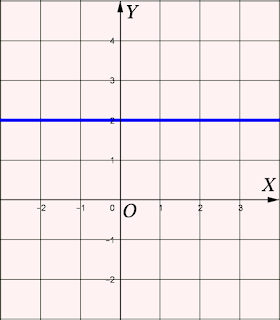1. Complete each sentence.
$\text{(a)}\quad$ The slope of the line passing through two points $(-6, 0)$ and $(2, 3)$ is __________.
$\text{(b)}\quad$ The slope of the line joining the point $(1, 2)$ and the origin is __________.
$\text{(c)}\quad$ A vertical line has __________ slope.
$\text{(d)}\quad$ A horizontal line has __________ slope .
$\text{(a)}\quad$ The slope of the line passing through two points $(-6, 0)$ and $(2, 3)$ is __________.
$\text{(b)}\quad$ The slope of the line joining the point $(1, 2)$ and the origin is __________.
$\text{(c)}\quad$ A vertical line has __________ slope.
$\text{(d)}\quad$ A horizontal line has __________ slope .
Show/Hide Solution
2. For each graph state whether the slope is positive, negative, zero or undefined, then find the slope if possible.
Show/Hide Solution
3. Which pairs of points given below will determine horizontal lines? Which ones vertical lines? Determine the slope of each line without calculation.
$\displaystyle \begin{array}{l} \text{(a)}\quad (5,2)\ \text{and}\ (-3,2) \\\\ \text{(b)}\quad (0,5)\ \text{and}\ (-1,5)\\\\ \text{(c)}\quad (2,3)\ \text{and}\ (2,6) \\\\ \text{(d)}\quad (0,0)\ \text{and}\ (0,-2)\\\\ \text{(e)}\quad (1,-2)\ \text{and}\ (-3,-2)\\\\ \text{(f)}\quad (a,b)\ \text{and}\ (a,c) \end{array}$
$\displaystyle \begin{array}{l} \text{(a)}\quad (5,2)\ \text{and}\ (-3,2) \\\\ \text{(b)}\quad (0,5)\ \text{and}\ (-1,5)\\\\ \text{(c)}\quad (2,3)\ \text{and}\ (2,6) \\\\ \text{(d)}\quad (0,0)\ \text{and}\ (0,-2)\\\\ \text{(e)}\quad (1,-2)\ \text{and}\ (-3,-2)\\\\ \text{(f)}\quad (a,b)\ \text{and}\ (a,c) \end{array}$
Show/Hide Solution
4. Find the slope of each line which contains each pair of points listed below.
$ \displaystyle \begin{array}{l} \text{(a) }\quad A(0,0)\ \text{ and }\ B(8,4)\\\\ \text{(b) }\quad C(10,5)\ \text{ and }\ D(6,8)\\\\ \text{(c) }\quad E(-5,7)\ \text{ and }\ F(-2,-4)\\\\ \text{(d) }\quad G(23,15)\ \text{ and }\ H(18,5)\\\\ \text{(e) }\quad I(-2,0)\ \text{and }\ J(0,\ 6)\\\\ \text{(f) }\quad K(15,6)\ \text{ and }\ L(-2,23) \end{array}$
$ \displaystyle \begin{array}{l} \text{(a) }\quad A(0,0)\ \text{ and }\ B(8,4)\\\\ \text{(b) }\quad C(10,5)\ \text{ and }\ D(6,8)\\\\ \text{(c) }\quad E(-5,7)\ \text{ and }\ F(-2,-4)\\\\ \text{(d) }\quad G(23,15)\ \text{ and }\ H(18,5)\\\\ \text{(e) }\quad I(-2,0)\ \text{and }\ J(0,\ 6)\\\\ \text{(f) }\quad K(15,6)\ \text{ and }\ L(-2,23) \end{array}$
Show/Hide Solution
5. Find the slope of each line which contains each pair of points listed below.
$ \displaystyle \begin{array}{l} \text{(a) }\quad E\left( {\displaystyle\frac{3}{4},\frac{4}{5}\text{ }} \right)\ \text{and }\ F\left( {-\displaystyle\frac{1}{2},\frac{7}{5}} \right)\\\\ \text{(b) }\quad G(-a,b)\ \text{ and }\ H(3a,2b)\\\\ \text{(c) }\quad L\left( {\sqrt{{12}},\sqrt{{18}}} \right)\ \text{ and }\ M\left( {\sqrt{{27}},\sqrt{8}} \right)\\\\ \text{(d) }\quad P(0,a)\ \text{ and }\ Q(a,0) \end{array}$
$ \displaystyle \begin{array}{l} \text{(a) }\quad E\left( {\displaystyle\frac{3}{4},\frac{4}{5}\text{ }} \right)\ \text{and }\ F\left( {-\displaystyle\frac{1}{2},\frac{7}{5}} \right)\\\\ \text{(b) }\quad G(-a,b)\ \text{ and }\ H(3a,2b)\\\\ \text{(c) }\quad L\left( {\sqrt{{12}},\sqrt{{18}}} \right)\ \text{ and }\ M\left( {\sqrt{{27}},\sqrt{8}} \right)\\\\ \text{(d) }\quad P(0,a)\ \text{ and }\ Q(a,0) \end{array}$
Show/Hide Solution
6. Find $p, q, r$ in the followings:
$\text{(a) }\quad$ The slope joining the points $(0,3)$ and $(1,p)$ is $5$.
$\text{(b) }\quad$ The slope joining the points $(-2, q)$ and $(0,1)$ is $-1$.
$\text{(c) }\quad$ The slope joining the points $(-4, -2)$ and $(r, -6)$ is $-6$.
$\text{(a) }\quad$ The slope joining the points $(0,3)$ and $(1,p)$ is $5$.
$\text{(b) }\quad$ The slope joining the points $(-2, q)$ and $(0,1)$ is $-1$.
$\text{(c) }\quad$ The slope joining the points $(-4, -2)$ and $(r, -6)$ is $-6$.
Show/Hide Solution
7. Find the slope corresponding to the following events.
$\text{(a) }\quad$ A man climbs $10$ m for every $200$ meters horizontally.
$\text{(b) }\quad$ A motorbike rises $20$ km for every $100$ kilometers horizontally.
$\text{(c) }\quad$ A plane takes off $35$ km for every $5$ kilometers horizontally.
$\text{(d) }\quad$ A submarine descends $120$ m for every $15$ meters horizontally.
$\text{(a) }\quad$ A man climbs $10$ m for every $200$ meters horizontally.
$\text{(b) }\quad$ A motorbike rises $20$ km for every $100$ kilometers horizontally.
$\text{(c) }\quad$ A plane takes off $35$ km for every $5$ kilometers horizontally.
$\text{(d) }\quad$ A submarine descends $120$ m for every $15$ meters horizontally.
Show/Hide Solution
8. A train climbs a hill with slope $0.05$. How far horizontally has the train travelled after rising $15$ meters?
Show/Hide Solution
9. The vertices of a triangle are the points $A(-2,3)$, $B(5,-4)$ and $C(1,8)$. Find the slope of each side and perimeter of a triangle.
Show/Hide Solution
10. The vertices of a parallelogram are the points $P(1,4)$, $Q(3,2)$, $R(4,6)$ and $S(2,8)$. Find the slope of each side.
Show/Hide Solution
11. A line having a slope of $-1$ contains the point $(-2,5)$. What is the $y$-coordinate of the point on that line whose $x$-coordinate is $8$?
Show/Hide Solution
စာဖတ်သူ၏ အမြင်ကို လေးစားစွာစောင့်မျှော်လျက်!









